I recently had the unique pleasure of going on behalf of Atlas F1 to the British Grand Prix at Silverstone, to the CART race at Nazareth (the original date was snowed out!), and - 24 hours later - to the IRL's Indy 500 at Indianapolis. Observing all three forms of the major open-wheel formulas at close range in close succession, I can report on what I saw and felt as I soaked in the atmosphere at these three different racetracks - two of them American ovals, one of them a World War II airfield turned road racing circuit.
First, what was the racing like at each track? As it happened, there was good racing at all three of these tracks, but in terms of the current chief complaint of Formula One fans - the absence of overtaking - both of the American-based formulas had an abundance of passing. Is it the slicks (both CART and IRL have them), the turbos (CART only, a 2.65 liter V8 turbo), the tracks, the drivers, what? It seems that the track played the major role in creating competitive racing amongst the CART cars at Nazareth, and the closely-matched cars of the IRL were the main reason for the close racing at Indy.
Nazareth - CART
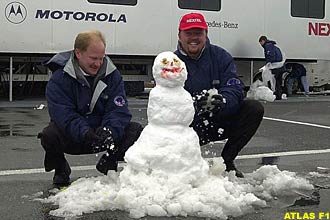 Nazareth is a tiny, former dirt track built in the hometown of Mario and Michael Andretti that measures less than 1 mile - a "bullring" they call it. The small scale of the place makes the racing very accessible to the fans; indeed, the grandstands are so close to the track that in the lower rows down near the trackside there is a real sense of danger as 20 cars attempt to keep out of each other's way while simultaneously trying to set each other up for a pass.
Nazareth is a tiny, former dirt track built in the hometown of Mario and Michael Andretti that measures less than 1 mile - a "bullring" they call it. The small scale of the place makes the racing very accessible to the fans; indeed, the grandstands are so close to the track that in the lower rows down near the trackside there is a real sense of danger as 20 cars attempt to keep out of each other's way while simultaneously trying to set each other up for a pass.
There were many breathtaking passes during the Nazareth race, several compliments of Juan Montoya, who in one afternoon passed more people for position than Michael Schumacher is likely to overtake all season.
And the people he was passing were no slouches: on one re-start, Montoya got the jump on Paul Tracy, who is as difficult to pass as the legendary Andrea de Cesaris in Formula One; on another re-start, Montoya took on Michael Andretti, one of the bravest and most savvy of the CART drivers, and managed to get by him - and on Andretti's home ground at that.
The backstretch at Nazareth provided some of the most exciting passing as the frontrunners periodically caught up to the backmarkers as they raced slightly uphill (there is a 34 foot elevation change at Nazareth) and the traffic provided the opportunity for drivers to outbrake one another as they moved forward through the backmarkers on the backstretch.
Nazareth is a strange little track for these powerful 800 bhp cars, and a real throwback to an earlier era of sprint cars from whence the CART cars come. Given the origins of Nazareth, it does not take much imagination to visualize a young Mario Andretti three-wheeling a dirt track car and kicking up the dust around the oddly shaped turns of this busy little track. In the end, Gil de Ferran won the race for Marlboro Team Penske (an historic 100th Indycar victory for Roger Penske) but Montoya, who finished fourth, was eviscerating all comers until he got involved in an accident not of his making on the front stretch, in which he damaged his front wing and was forced to pit to replace the wing, giving up his position in the top three in the process.
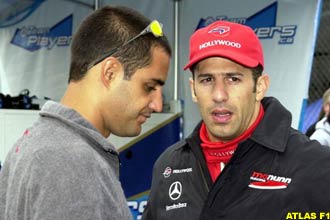 Nazareth was a wonderfully fan-friendly place. Anyone who wanted to could get into the paddock area on race day for a $30 pit pass and find themselves cheek-by-jowl with the CART inner circle. Juan Montoya and Jimmy Vasser practically ran me over as they made their way back to the paddock on their scooters - the famous teammates hanging out together even when the TV cameras weren't rolling for their "Target" commercials. Michael Andretti stood under the canopy in his garage area with not even a rope and stanchions keeping the fans at a respectful distance: the occasional teenager would walk right up to Michael and give him a program or hat to autograph but most onlookers seemed happy to get that close and no more, exercising self-restraint.
Nazareth was a wonderfully fan-friendly place. Anyone who wanted to could get into the paddock area on race day for a $30 pit pass and find themselves cheek-by-jowl with the CART inner circle. Juan Montoya and Jimmy Vasser practically ran me over as they made their way back to the paddock on their scooters - the famous teammates hanging out together even when the TV cameras weren't rolling for their "Target" commercials. Michael Andretti stood under the canopy in his garage area with not even a rope and stanchions keeping the fans at a respectful distance: the occasional teenager would walk right up to Michael and give him a program or hat to autograph but most onlookers seemed happy to get that close and no more, exercising self-restraint.
Several ex-Formula One drivers populate the CART group currently, including Christian Fittipaldi, Mauricio Gugelmin, Mark Blundell, Roberto Moreno, Shinji Nakano, Norberto Fontana and of course, Michael Andretti. Another transfer student is Swedish driver Kenny Brack, who last year was in the IRL and won the 1999 Indy 500 for A.J. Foyt, this year moving "up" to CART as Nakano moves "down" to CART after being away from Formula One for a year.
CART seems to be settling in as the intermediate open-wheel series. The last time we saw Nakano he was driving for Minardi at the 1998 Japanese Grand Prix; he was sidelined at Nazareth because of injuries but had finished 8th in Homestead, the first race of the CART season. Fontana, formerly with Sauber, has also just joined the CART series and participated in the Nazareth race; unfortunately, he hit the wall on lap 114 and was out of the race.
The CART paddock at Nazareth was a more relaxed place than Nakano and Fontana would have been used to in Formula One. At one point I was in the Target Team Ganassi garage area and I saw Juan Montoya spot Chip Ganassi sitting alone on a trunk in the middle of a work area, probably contemplating a weekend that would sorely test him and his team because he was racing in two different circuits (Nazareth and Indianapolis) in two different formulas (CART and the IRL) in one weekend. Juan strolled over and gave Chip an enthusiastic "high five", as if they were two guys playing college basketball. I can't wait to see Montoya "high five" with Patrick Head!
After witnessing a spirited race at Nazareth, we drove all night some 600 miles to reach Indianapolis for the Indy 500. We were not alone on the Pennsylvania Turnpike: all three of the Team Ganassi transporters swooped by us at speeds that indicated that their pit-speed limiter buttons were inoperative. The Ford Cosworth and Bridgestone support trucks also accompanied us across the American Midwest, but ultimately gave it up and were seen parked at a motel in the wee hours. Noberto Fontana's Della Penna Motorsports team caught up to us at one of our own refueling stops. And meanwhile, in the skies above us, Chip Ganassi, Juan Montoya and Jimmy Vasser got to Indy in style, in Chip's Lear Jet, whose aircraft registration number is N"500"CG.
Indianapolis - IRL
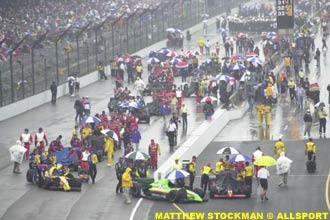 If Nazareth nuzzles you with its closeness and intimacy, Indianapolis has just the opposite effect and overwhelms you with its sheer monumental scale - 2.5 miles around, over 375,000 seats, a golf course, a museum, a brand new Pagoda-style control tower, new box seats and new media facilities, much of the facelifting at the insistence of the FIA and Bernie Ecclestone in anticipation of bringing Formula One to Indianapolis this coming September.
If Nazareth nuzzles you with its closeness and intimacy, Indianapolis has just the opposite effect and overwhelms you with its sheer monumental scale - 2.5 miles around, over 375,000 seats, a golf course, a museum, a brand new Pagoda-style control tower, new box seats and new media facilities, much of the facelifting at the insistence of the FIA and Bernie Ecclestone in anticipation of bringing Formula One to Indianapolis this coming September.
The Indy 500 calls itself "The Greatest Spectacle in Racing" and it is hard to argue with that description. But thirty dollars won't get you into Gasoline Alley on race day as it will at Nazareth; credentials are, as in Formula One, carefully controlled and made available to the media, the Sponsors and the Rich and Famous and there are many fans hanging on the fences at the points where the drivers exit Gasoline Alley and enter the pits - "knucklers" these ardent fans are called by those on the inside of the fence, as they hang on the chain link fence and bide their time waiting for a glimpse of Eddie Cheever, Greg Ray, Sarah Fisher or Buddy Lazier.
On the other hand, as at Nazareth, intimacy and a sense of community somehow gets communicated at Indy, all the more amazing given its vastness. Spectators who had seats in the grandstands near the pits could rub shoulders with the Unites States Secretary of Defense, William Cohen, who was an honorary guest, closely-shadowed by a spiffy-looking Marine Officer carrying a bag with the State Secrets, just in case we had to bomb Iraq during the Indy 500.
Then there is the corny but warm rendering of "Back Home in Indiana" sung by Jim Nabors, the balloons, the artillery guns salute, the prayer for a safe race (which has often gone unanswered but happily worked this year) and finally, the air display of Harrier Jump Jets doing their thing up and down the front straight at Indy. At Nazareth and Silverstone, air shows and aerobatic trick flying are the order of the day; at Indy, it is more like War Games, an awesome display of whatever military hardware is in vogue that year. In the year of the Gulf War, four A-10 Thunderbolt Warthogs did some impressive flyovers; last year a Stealth Bomber banked into the Speedway airspace and was halfway across the infield before anyone noticed!
All this Midwest Americana bordering on jingoism somehow cements the immense crowd that comes to Indy. This year the fans on the front straight from Turn 1 down to Turn 4 did "The Wave" - perhaps 60,000 people acting in unison. It will be interesting to see how this unique atmosphere translates when Formula One comes to Indy.
 As to the racing at Indy, on what would turn out to be Juan Montoya Memorial Day Weekend, Montoya and Ganassi's team showed the way in a terrific race that had it all: on lap 27 of the 200 lap race, Montoya passed pole-sitter Greg Ray, only to be re-passed by Ray on the next lap; ex-Formula One driver and 1998 Indy 500 winner Eddie Cheever moved up from 10th on the grid to second place behind Montoya by lap 58; Brazilian rookie Ayrton Dare ran as high as 3rd place; 53 year-old Lyn St. James tangled with the only other woman driver in the field, 19 year-old Sarah Fisher, putting them both out on lap 74; and in the best racing of the day, American and 1996 Indy 500 winner Buddy Lazier chased down Colombian Juan Montoya (now living in Miami) to the roar of the hundreds of thousands of people in the stands. Not even the klaxon-horns-and-fireworks-wielding Schumacher fans in the stadium area at Hockenheim create the kind of collective noise that you see and feel at Indy when things get hot.
As to the racing at Indy, on what would turn out to be Juan Montoya Memorial Day Weekend, Montoya and Ganassi's team showed the way in a terrific race that had it all: on lap 27 of the 200 lap race, Montoya passed pole-sitter Greg Ray, only to be re-passed by Ray on the next lap; ex-Formula One driver and 1998 Indy 500 winner Eddie Cheever moved up from 10th on the grid to second place behind Montoya by lap 58; Brazilian rookie Ayrton Dare ran as high as 3rd place; 53 year-old Lyn St. James tangled with the only other woman driver in the field, 19 year-old Sarah Fisher, putting them both out on lap 74; and in the best racing of the day, American and 1996 Indy 500 winner Buddy Lazier chased down Colombian Juan Montoya (now living in Miami) to the roar of the hundreds of thousands of people in the stands. Not even the klaxon-horns-and-fireworks-wielding Schumacher fans in the stadium area at Hockenheim create the kind of collective noise that you see and feel at Indy when things get hot.
Although Lazier's challenge ultimately faded after a gallant charge, it was the kind of sustained close racing that is rare at any track but seems to be emblematic of the best Indy 500's, which, after all those miles, have often come down to two cars duking it out on the fourth turn on the final lap and carrying the race down the main straight to the one yard of original bricks that marks the finish line.
Silverstone - Formula One
Silverstone, it must be said, has had better years than this year's now-legendary rain-soaked weekend but I had a fabulous time anyway and recommend it highly, recognizing that this could be a minority view after this year's debacle.
I had been to Silverstone in 1996 with an organised tour that was led by Phil Hill so I knew the lay of the land and decided to stay in the countryside as near to Silverstone as I could get. Fortuitously, I stayed at Crockwell Farm - a charming working farm/bed and breakfast, located between the tiny villages of Canons Ashby and Eydon, about twenty minutes by car on a normal day to Towcester (pronounced "Toaster" for you Yanks) where Silverstone is located.
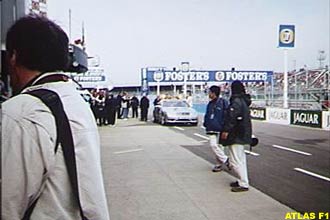 When the rains and fog came, The Farmer and his Wife - Bay and Hermione Harper - simply arranged by means of a neighbor, John Taylor, and themselves to drive their race-fan guests to the outskirts of the Village of Silverstone where we hiked in the rest of the way, returning to the same pre-determined point at day's end for pick-up, thus avoiding the "Quagmire in the Car Parks" that ruined the weekend for so many. Dividing my time between the placidity of the horses, sheep and rolling hills of Canon's Ashby and the ear-splitting sounds I heard during Sunday's warm-up made for a jarring but exhilarating Weekend in the Country.
When the rains and fog came, The Farmer and his Wife - Bay and Hermione Harper - simply arranged by means of a neighbor, John Taylor, and themselves to drive their race-fan guests to the outskirts of the Village of Silverstone where we hiked in the rest of the way, returning to the same pre-determined point at day's end for pick-up, thus avoiding the "Quagmire in the Car Parks" that ruined the weekend for so many. Dividing my time between the placidity of the horses, sheep and rolling hills of Canon's Ashby and the ear-splitting sounds I heard during Sunday's warm-up made for a jarring but exhilarating Weekend in the Country.
And as with the CART cars at Nazareth and the IRL cars at Indy, the Formula One cars put on a good show at Silverstone but the supporting races and the ancillary elements of Silverstone made it the most complete experience for a can't-get-enough-of-it race fan like me. Having squandered thousands of dollars over the years on various Jaguar E-Types, the hypochondriac of the sports car set, what could be better than to come upon Jaguar's display of historic cars, with C-Types and D-Types all around and being driven to and from their canopies in the rainy conditions, engines purring and roaring by turns? Okay, it's not Le Mans and the Mulsanne Straight in 1955, but you do not get this at Nazareth or Indy. And, even at Indy, the manufacturers do not go out of their way to set up the kind of Formula One dealership row that is presented at Silverstone, with Mercedes-Benz and Jaguar going all out to promote their products.
The other thing about Silverstone are the die-hard fans, every bit as rabid as those at Indy or Hockenheim, if a bit better mannered and extremely well informed. When I was there in 1996, the Damon Hill Union Jack flags were all through the Luffield complex; this year the roars at Becketts were for Jenson Button who, though a tyro at all this, somehow managed to win over the entire crowd that weekend, as if fellow Brits - Herbert, Irvine and ultimate winner Coulthard - did not even exist.
Surprisingly, the other figure who was, relatively speaking, ignored that weekend, was Michael Schumacher. Barrichello had taken pole on Saturday and by Sunday morning warm up, it was Rubens Barrichello - not Michael Schumacher - that was the focus of the media. In the Ferrari garage area, Michael chatted with Jean Todt and kept his fingers in his ears as the mechanics warmed up the 3.0 liter V10 engine, while two garages over the photographers swarmed around Rubinho.
But out there on the Spectator Banking at Becketts we all enjoyed the race and it was nice to see Barrichello have his day in the sun for a change. Those further down the Spectator Banking also got to see Coulthard pass Barrichello on lap 30 when the Ferrari hydraulics acted up and Barrichello spun in the grass, ultimately retiring from the race after this episode. And it was fun for the crowd to see Jenson Button stay up with or ahead of his teammate Ralf Schumacher for much of the race.
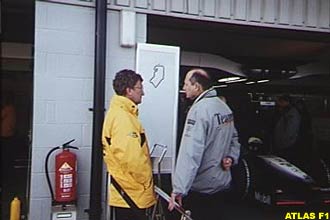 Meanwhile, a mile or so from Becketts and down in the paddock area and on the pitlane, the Powers That Be in Formula One went about their business in a sumptuous Backstage setting worthy of Hollywood. Instead of the makeshift tent-like canopies of Nazareth, Pennsylvania or even the concrete garages of Gasoline Alley at Indy, the splendiferous motorhomes of the Formula One teams were laid out on a kind of Rodeo Drive in Los Angeles, or the Ramblas in Barcelona.
Meanwhile, a mile or so from Becketts and down in the paddock area and on the pitlane, the Powers That Be in Formula One went about their business in a sumptuous Backstage setting worthy of Hollywood. Instead of the makeshift tent-like canopies of Nazareth, Pennsylvania or even the concrete garages of Gasoline Alley at Indy, the splendiferous motorhomes of the Formula One teams were laid out on a kind of Rodeo Drive in Los Angeles, or the Ramblas in Barcelona.
Flavio Briatore could be seen schmoozing with Gerhard Berger; ex-Formula One driver now TV commentator John Watson congratulating Rubens on getting pole; Bernie monitoring it all from the steel-grey bus parked in splendid solitude near the Media Tower; Max headquartered in the FIA Presidential Suite over by Woodcote Corner; and Eddie Irvine chowing down in the Jaguar motorhome, which featured a gigantic version of Jaguar's chrome leaping cat hood ornament, projecting out from the top of the motorhome.
Incongruously, NASCAR's Johnny Benson was also visiting Silverstone that weekend, and also spotted running between the raindrops was the dashing Earl of March, the impresario of The Goodwood Festival of Speed, who got the Best Dressed Man award that horrendous weekend, elegantly turned out in a tan raincoat and hobnobbing from motorhome to motorhome like someone running for political office.
And on the pitlane there were more revealing Backstage sights. By virtue of their finishes in last year's constructor's race, the Jordan and McLaren teams are next to one another on the pitlane and two people who you would think were Night and Day - Eddie Jordan and Ron Dennis - chatted amiably and at length over the ropes dividing their garage area, like neighbors in the suburbs talking over a backyard fence.
Meanwhile, in the McLaren garage, David Coulthard sat alone behind his car toward the back of the garage, a handsome, chiseled figure looking almost as if he were a model posing. Ralf Schumacher sat on the rear left tire of his Williams-BMW watching the TV monitors in his garage and looked like he was champing at the bit to get in and give it a go.
Further down the pitlane in the low-rent district, the atmosphere differed from team to team. Jacques Villeneuve was horsing around with his mechanics while we all waited for the fog to lift on the morning of the race. The Minardi garage (that Telefonica yellow, by the way, which was also on Spaniard Oriol Servia's CART car at Nazareth, has to be seen to be believed) was open to anyone who wanted to walk in, with no restraining rope line and everyone seemed to be having fun. The Arrows pit was surprisingly teaming with activity and emitted much energy (and color too with all that Orange), to little effect in the race as it turned out, but my sense was that though still a backmarker this team is serious about getting better, as Jordan was last year.
 For all of the frenzy of the Arrows garage, all was quiet in the McLaren garage; no last minute scurrying about. Ferrari, however, lived up to its billing as a mix of Italian temperament and German attention to detail. More active than their next door neighbors at McLaren, the Scuderia seemed passionate but purposeful. One mechanic's job was to hold a tailored, yellow leather cover for the now-famous Ferrari Barge Boards, which was put into place as soon as Schumacher and Barrichello came back from a run; there were also form-fitting covers for the front wing, complete with FEDEX logos, naturally. Another team member's job was to be a traffic cop, gauging the best time to fit the Ferraris into the traffic flow of the busy pitlane. Jean Todt seems to actually manage the place and he and Michael conferred from time to time before Todt and Ross Brawn headed for the bank of monitors overlooking the pit straight.
For all of the frenzy of the Arrows garage, all was quiet in the McLaren garage; no last minute scurrying about. Ferrari, however, lived up to its billing as a mix of Italian temperament and German attention to detail. More active than their next door neighbors at McLaren, the Scuderia seemed passionate but purposeful. One mechanic's job was to hold a tailored, yellow leather cover for the now-famous Ferrari Barge Boards, which was put into place as soon as Schumacher and Barrichello came back from a run; there were also form-fitting covers for the front wing, complete with FEDEX logos, naturally. Another team member's job was to be a traffic cop, gauging the best time to fit the Ferraris into the traffic flow of the busy pitlane. Jean Todt seems to actually manage the place and he and Michael conferred from time to time before Todt and Ross Brawn headed for the bank of monitors overlooking the pit straight.
The single most astounding sight at close range during warm up was seeing Schumacher's Ferrari exit the garage on an installation lap in all of its color, chrome and finery, exceeded only the heart-stopping return a minute and twenty seconds later when Schumacher's car stopped in the first pit box from great speed on a dime and he leapt out of it as if it were on fire to go and confer with his mechanics. (His leg is definitely better!) Interestingly, Schumacher pulls into the pit box on his yellow marks as if to practice for pit stops even on an installation lap; a brave crew member also stands just beyond the yellow pit box marks to lift the nose of the car with the jack as he will do for real later on in the race. These guys don't miss a trick!
It was also interesting to see the different "management styles" apparent on the pitlane, at least during the warm up period, which is a kind of low-pressure quiet before the storm. As mentioned, Ron and Eddie chewed the fat; in another grouping, Flavio Briatore and Tom Walkinshaw met with Eddie Baker of the Digital TV Production Center to discuss the fog holding up the proceedings; Berger and Norberg Haug were out and about kibitzing, exceeded in gregariousness only by Briatore. In the BAR-Honda garage, the Japanese executive bigwigs responsible for the factory Honda engines looked on in isolation from their British counterparts; in addition, I did not sense in the BAR garage the camaraderie Senna had supposedly forged with his Japanese mechanics during the dominant era of the McLaren-Honda.
A final feature of attending the Silverstone race that could not be matched at Nazareth and Indy was the last event of the weekend: the historic sports car race, where some of the classic Aston Martins, Listers, Jaguars, Lotuses, Cooper Monacos, Birdcage Maseratis and Ferraris from the 1950s that have inspired so much of the history of motor racing put on a spirited display under threatening skies that ultimately ended in rain as Easter Sunday and my weekend at the British Grand Prix also ended.
Back Home - Epilogue
Which was my favorite of the three venues? Much as I love the American spectacle that is Indy and the small-town county fair atmosphere of Nazareth, I have to concede that for all of the shortcomings and excess of Formula One racing these days, spending a three-day weekend taking in all that Silverstone has to offer - even under inclement conditions - is one of the maximum experiences for a race fan.
But I am willing to bet that the kind of merger of the two open-wheel worlds of Formula One and the Indycars that is represented by the return of Formula One to America and to the Indianapolis Motor Speedway will create a spectacular race weekend for those lucky enough to be there to see it and I intend to be one of them.
See you on the Pennsylvania Turnpike!

